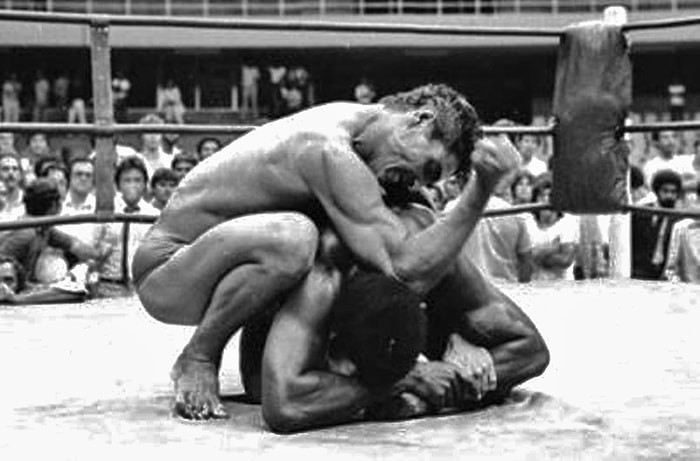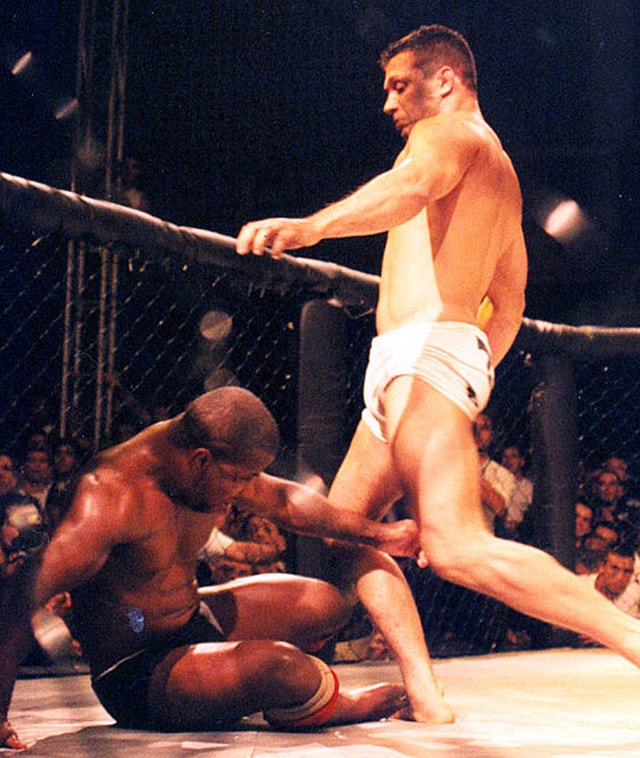Vale Tudo: Brazil’s Ultimate Freestyle Fighting
Vale Tudo, a term meaning everything goes or no holds barred in Portuguese, is a combat sport originating from Brazil. The sport emerged in the early 20th century and gained popularity through Brazilian jiu-jitsu practitioners such as the famous Gracie family.
Vale Tudo matches are known for having no rules, and fighters compete at maximum intensity. The total lack of rules and hyperfocus on discovering the best martial art allowed it to become one of the main influences of modern mixed martial arts (MMA). Were going to explore Vale Tudo, its wild, unique history, and, of course, its link to mixed martial arts. Let’s enter the extreme world of Vale Tudo!
Origins and History of Vale Tudo

1920s–1980s: The Early Years
Vale Tudo originated in Brazil in the early 20th century, where it was influenced by martial arts disciplines like Capoeira and Brazilian Jiu-Jitsu. The term “Vale Tudo” translates to “anything goes,” and the sport lived up to its name. Fights were characterized by no rules and no protective equipment. Fighters from different martial arts backgrounds would compete in Vale Tudo matches, including Judo, Karate, Muay Thai, and Brazilian Jiu-Jitsu.
Vale Tudo had informal challenge matches, which were often held during Brazilian carnivals. Fighters from various martial arts disciplines would compete against each other to prove the superiority of their styles.
The Gracie family was crucial in the shaping of Vale Tudo. Carlos and Helio Gracie, the founders of Brazilian Jiu-Jitsu, organized and participated in numerous challenge matches to showcase the effectiveness of their martial art. Challenge matches were organized to find out who had the best martial arts style.
Brazil’s diverse population included practitioners with a variety of martial arts backgrounds, such as judo, capoeira, luta livre, and boxing. This variety created an ultra-competitive environment where fighters sought to prove how effective their martial arts styles were. Cross-competition often took place because of this; for example, a judo fighter would fight a karate fighter with no rules. The aim was only to win, and the matches had no time limit. The objective was to win by knockout or have the opponent quit. Luta livre fighters played a significant role in these early years, especially under Vale Tudo rules, leading to memorable confrontations with practitioners from other styles.
In the 1930s and 1940s, the Gracie family promoted Vale Tudo matches through the newspapers and radio, increasing public interest and awareness. These matches were often promoted as tests of martial arts superiority. This was in large part what made Vale Tudo fights so popular; the audience showed up not only to see an intense fight but also to find out which martial arts style would win.
The Golden Age of Vale Tudo (1993–2000s)

Rise to Prominence and Notoriety
The Gracie family played a significant role in the development of Vale Tudo, with Carlos and Helio Gracie being pioneers of Brazilian Jiu-Jitsu.
Vale Tudo laid the groundwork for the modern sport of MMA, which was formalized in the 1990s.
The Ultimate Fighting Championship (UFC) was a Vale Tudo-style tournament held in the late 1990s, organized by Rorion Gracie and his family.
Royce Gracie, a member of the Gracie family, dominated the event, winning the tournament and cementing the reputation of BJJ as a legitimate martial art.
Brazilian Jiu Jitsu was a big winner in Vale Tudo fights, and it became infamous for being a large part of the sport. Of course, it was not the only style that would win fights, and Vale Tudo fighters eventually started blending techniques into a type of foundation of mixed martial arts. Karate fighters started practicing judo and Brazilian Jiu Jitsu, and vice versa. This blend of martial arts is widely recognized to be the foundation of modern mixed martial arts.
Vale Tudo’s Influence on Modern MMA
The pioneers of Vale Tudo fighting also went on to be some of the most iconic names in mixed martial arts history! They are considered the first to ever compete in mixed martial arts, and without these fighters, the sport would probably not be around today. Here are some of the fighters well known for competing in both Vale Tudo and MMA:
- Helio Gracie – One of the founders of Brazilian Jiu-Jitsu and a key figure in early Vale Tudo. Helio Gracie was one of the earliest Vale Tudo fighters, and his success in Vale Tudo is a big reason the sport went on to be so popular in Brazil.
- Rickson Gracie – Helio’s son, is known for his Vale Tudo and early MMA matches. Rickson Gracie was very accomplished in both Vale Tudo and later on in MMA; he even had a career in the Pride Fighting Championship.
- Royce Gracie – Popularized Brazilian Jiu-Jitsu in the first UFC events and fought in UFC 1, the first ever televised event to take place.
- Marco Ruas – Known as one of the first true mixed martial artists, combining striking and grappling. He used all the fighting styles combined to gain the victory, something that was not seen much before in Brazil.
- Kazushi Sakuraba – Became famous for his fights against the Gracie family; he defeated multiple members of the family and even became known as “The Gracie Hunter.” Kazushi Sakuraba went on to become an iconic fighter for Pride FC.
- Wanderlei Silva – Silva’s relentless, aggressive approach earned him the nickname “The Axe Murderer.” He is known for his intense striking abilities, particularly his use of knees and punches in the clinch. Wanderlei Silva is perhaps the most famous vale tudo fighter on this list. When he entered MMA, he earned a reputation for his vicious knockout power.
These fighters fought in Vale Tudo events, Pride Fighting Championship events, and some of the first UFC events to ever take place. They are truly pioneers of mixed martial arts, and they used their Vale Tudo backgrounds to build MMA into the refined sport it is today.
Brazilian Jiu-Jitsu and Mixed Martial Arts
Vale Tudo’s emphasis on full-contact combat and “anything goes” fighting style has shaped the modern MMA landscape. The evolution of Vale Tudo mma from circus fighting in Brazil during the 1920s to its popularization through various martial arts events, particularly involving the Gracie family, played a crucial role in this transformation. This is mostly because Vale Tudo was dominated by fighters with Brazilian Jiu-Jitsu backgrounds. There were, of course, other fighters competing, such as those who specialized in striking martial arts, but generally, BJJ practitioners did very well in the early days of MMA and Vale tudo.
Today, the sport of mixed martial arts has evolved, and just being a Brazilian Jiu-Jitsu fighter is not really enough to reach the top levels of MMA. Modern MMA fighters now have backgrounds in various martial arts, such as Tae Kwon Do, Karate, Judo, Boxing, Sambo, wrestling, Muay Thai, and various other martial arts disciplines. However, as a general rule, most MMA fighters will practice Brazilian Jiu Jitsu, and this is because of the huge success it had in Vale Tudo and the early UFC fights. It is seen as a necessary part of mixed martial arts, and without basic knowledge of Brazilian Jiu Jitsu, it is usually not advised to compete.
Summary
Vale Tudo’s everlasting legacy can be seen in the popularity of MMA and Brazilian Jiu-Jitsu worldwide. The sport’s influence on modern MMA is undeniable, and without Vale Tudo, mixed martial arts may not exist today. Vale Tudo remains synonymous with Brazilian martial arts and combat sports; it is a testament to the hard work and resilience of the early Brazilian mixed martial arts fighters.
Frequently Asked Questions
Does Vale Tudo still exist?
Vale Tudo fights may still take place on a small scale, but these days most Vale Tudo fights have been replaced by MMA fights.
Is Vale Tudo bare-knuckle?
Yes Vale Tudo fights are bare knuckle.
What language is Vale Tudo?
The name Vale Tudo comes from the Portugese language, and it means anything goes or no holds barred.
What’s the difference between MMA and Vale Tudo?
The main difference between MMA and Vale Tudo is that MMA is an organized sport with a ruleset, whereas in Vale Tudo anything goes, meaning there are no rules.
What are the Vale Tudo rules?
Vale Tudo has no rules.










Pingback: Sambo vs BJJ: What’s the Best Form of Grappling?